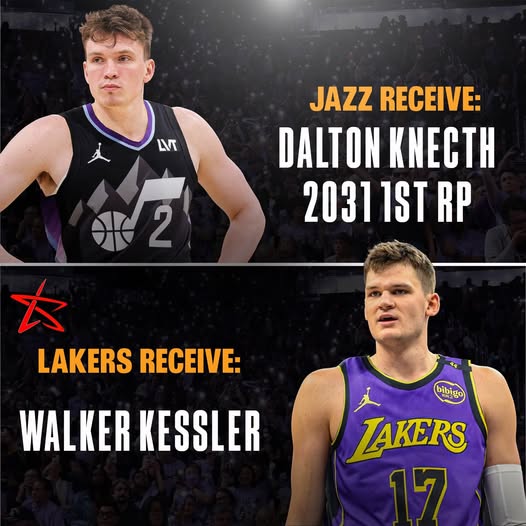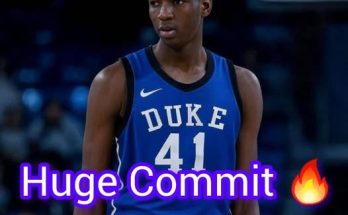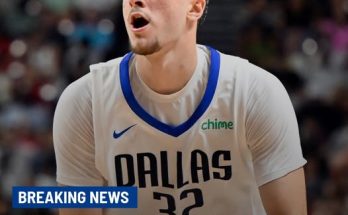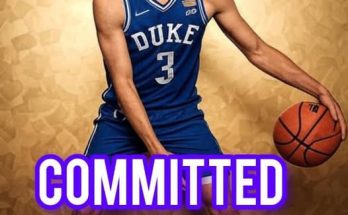The Los Angeles Lakers have once again shaken the NBA landscape with a bold move aimed at fortifying their frontcourt and intensifying their championship pursuit. In a stunning transaction, the Lakers have acquired rising star center Walker Kessler from the Utah Jazz in exchange for rookie sharpshooter Dalton Knecht, a 2031 unprotected first-round pick, a 2028 pick swap, and a 2030 pick swap. The move sends a clear message: the Lakers are all-in on building a title contender around LeBron James and Anthony Davis in the twilight of LeBron’s storied career.
Walker Kessler, a 7-footer known for his elite rim protection and shot-blocking ability, adds a much-needed defensive presence to a Lakers roster that struggled in the paint last season. Still just 23 years old, Kessler quickly emerged as one of the premier young big men in the league after being drafted by the Memphis Grizzlies in 2022 and traded to the Jazz on draft night. In his first two seasons, Kessler averaged 8.7 points, 8.2 rebounds, and 2.4 blocks per game while shooting an impressive 70% from the field—numbers that made him a standout on a rebuilding Utah squad.
For the Lakers, this trade is about more than statistics. It’s about identity. After an inconsistent 2024-25 campaign marred by defensive lapses, particularly in pick-and-roll coverage and rim protection, the team’s front office has made a concerted effort to recalibrate its roster around rugged defenders and elite role players. Kessler fits that mold perfectly. He is not only a dominant interior force but also a high-IQ defender who can anchor a team’s defensive scheme and take pressure off Anthony Davis, who has often been forced to shoulder the lion’s share of the defensive responsibilities.
The acquisition of Kessler also signals a philosophical shift. Rather than chasing high-usage offensive stars, the Lakers are focusing on complementary players who can enhance the core of LeBron and AD. With LeBron likely entering his final season or two, the front office recognizes that every piece must fit seamlessly to maximize their championship window. Kessler’s ability to run the floor, finish lobs, and deter shots at the rim makes him a perfect partner for Davis in the frontcourt.
The price, however, was steep. Dalton Knecht, the 17th overall pick in the 2024 NBA Draft, was viewed by many as a potential steal for L.A. after an electrifying senior year at Tennessee. Known for his smooth shooting stroke, offensive versatility, and high motor, Knecht had quickly become a fan favorite in summer workouts and early preseason hype. While he may not have been an immediate star, his long-term upside as a scorer and floor spacer made him one of the more valuable young assets on the Lakers’ roster.
In addition to Knecht, the Lakers also sent a 2031 unprotected first-round pick to Utah, a move that could be risky considering the unknowns that lie seven years ahead. They’ve also agreed to swap picks with Utah in both 2028 and 2030, giving the Jazz added flexibility to capitalize if the Lakers’ fortunes take a turn for the worse in the post-LeBron era.
From Utah’s perspective, this trade aligns with their long-term rebuilding vision. The Jazz are flush with draft capital and young talent but were clearly not ready to contend in the short term. By moving Kessler, they open up minutes for other developing bigs while acquiring a promising young wing in Knecht who could thrive in a larger role. The Jazz front office, led by Danny Ainge, continues to make bold moves to collect assets, and this deal gives them three potential high-upside picks to work with in future drafts.
Moreover, Utah avoids the dilemma of having to extend Kessler in the near future. With the new collective bargaining agreement emphasizing flexibility and cost control, the Jazz are opting for cap space, youth, and picks over locking into long-term deals with players who may not be part of their next true playoff run. It’s a gamble, but one that could pay dividends if Knecht blossoms into a dynamic scorer and the Lakers struggle in the post-LeBron, post-AD era.
As for the Lakers, this trade is about right now. The Western Conference is as loaded as ever, with teams like Denver, Minnesota, and Oklahoma City fielding deep, talented rosters. The Lakers needed an interior presence who could handle tough matchups like Nikola Jokic and Karl-Anthony Towns in a potential playoff series. Kessler, with his size and mobility, gives them a fighting chance.
Additionally, this move potentially sets up a new defensive identity. With Jarred Vanderbilt, Max Christie, Gabe Vincent, and now Walker Kessler, the Lakers have quietly built a core of defenders who can switch, rotate, and contest across positions. Darvin Ham, who was retained as head coach after a rocky second half to last season, will be expected to mold these pieces into a cohesive unit capable of slowing down the Western elite.
Still, questions remain. Will Kessler be able to thrive in a win-now environment with the pressure and expectations of playing alongside LeBron James? Can the Lakers’ training staff help him improve his mobility on the perimeter to keep up with today’s spread offenses? Will his limited offensive game restrict L.A. in half-court sets during crucial playoff possessions?
For now, the Lakers are betting that his strengths far outweigh his limitations. They’re banking on rim protection, rebounding, and defensive cohesion to complement their star power and keep them in the thick of the title race. It’s a move that reflects urgency—but also one rooted in logic and fit.
The Lakers now enter free agency and the rest of the offseason with a new direction. They’ve added a cornerstone piece without giving up Davis or Reaves, and with LeBron reportedly leaning toward returning for another season, there is renewed optimism in L.A. This isn’t a splashy superstar deal—but it could be the kind of move that pushes the Lakers from pretender to contender.
For the Jazz, it’s another step in their patient build toward long-term relevance. While fans may mourn the loss of a young star like Kessler, the influx of assets keeps Utah firmly in the mix for future big moves—whether via the draft or future trades.
Ultimately, this blockbuster trade may be judged years from now based on how those picks pan out or whether Knecht develops into a star. But in the short term, it’s a bold, calculated swing by the Lakers in pursuit of one more ring—and a sign that Rob Pelinka and the front office aren’t done making moves just yet.
In a league dominated by stars and headlines, the Lakers just made a trade that speaks volumes without a single All-Star being involved. And that might just be the smartest kind of blockbuster of all.



